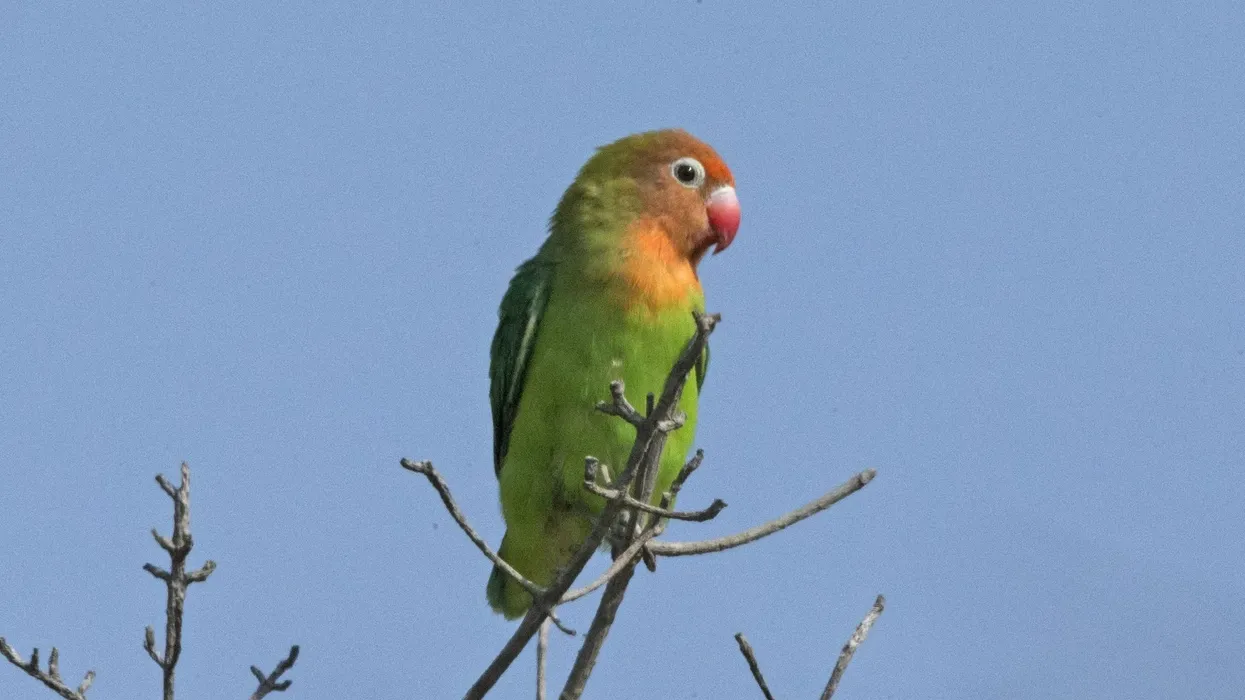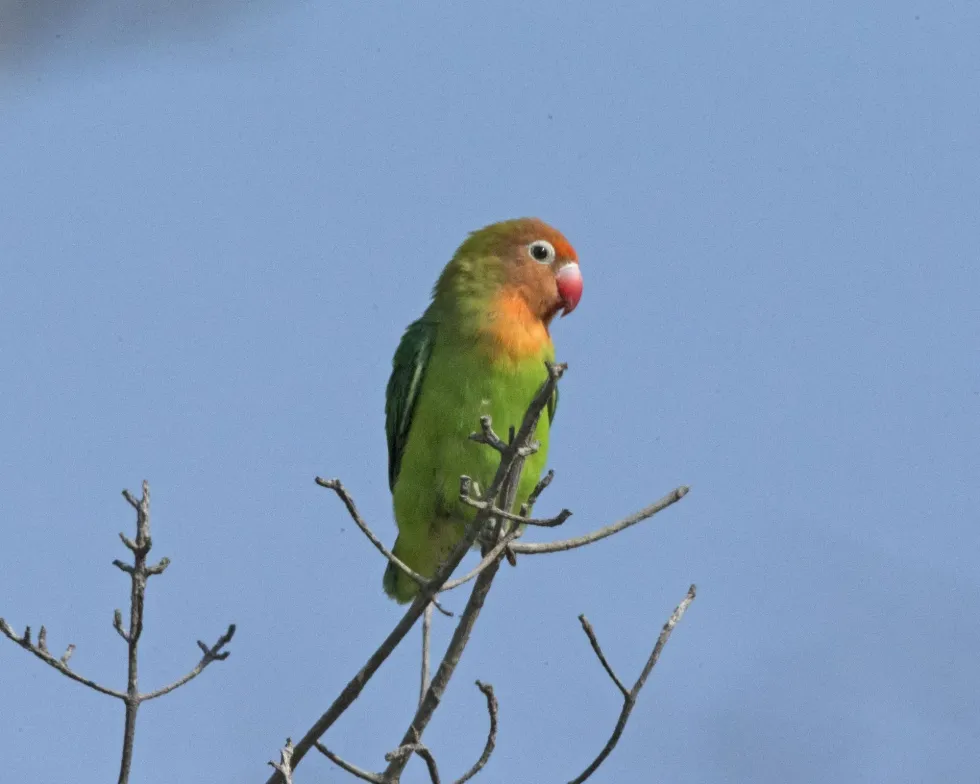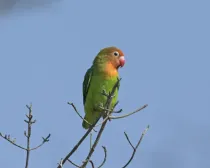Fun Lilian's Lovebird Facts For Kids

Love birds are tiny, multicolored parakeets that are highly attractive. The Lilian's lovebird (Agapornis lilianae), commonly known as the Nyasa lovebird (Lilian's), is a tiny African lovebird species with a long blunt tail. One of the least researched lovebird species is the Nyasa.
People have traditionally kept them as pets because of their social nature and intelligence, as well as their tiny stature and charming look. Their breeding season is from January to March. They do courtship feeding.
Read the article to know about it. The Lillian's lovebird is sometimes confused with the slightly bigger Fisher's lovebird, which has an olive-green hood and a blue tint. Also, take a look at our pheasant and exotic shorthair facts.
Lilian's Lovebird Interesting Facts
What type of animal is a Lilian's lovebird?
It is a tree nest breeding bird.
What class of animal does a Lilian's lovebird belong to?
It belongs to the class Aves.
How many Lilian's Lovebirds are there in the world?
Its overall population distribution might be as high as 20,000 or as low as 10,000. They have vanished from the Lower Zambezi River, possibly as a result of habitat degradation.
Where does a Lilian's lovebird live?
The Lilian's lovebird wild habitat may be found in Malawi, Mozambique, Tanzania, Zambia, and Zimbabwe. The wild area was believed to have less than 20,000 inhabitants in 2004. It is now found in Leonard National Park (LNP), and numerous cluster groups may be found in the adjacent woodlands outside of the park.
What is a Lilian's lovebird habitat?
In the south of its wild habitat distribution, the species is most commonly found in Colophospermum mopane woodland, although it also lives in Acacia on alluvium belts and riparian wild forest. Their habitat distribution is in wild fig trees to the north of their range.
Who does Lilian's lovebird live with?
This love-bird is a loving and sociable bird, as their name suggests. They congregate in groups called flocks.
In the morning, flocks of these birds preen and vocalize before departing as a group to graze. The Lilian's lovebird is a sociable bird that lives in groups of around 20 individuals. Pairs and small and big flocks may be found in tall broadleaf mopane and thorn tree woods, where they can be found in abundance.
They frequently perch in close proximity to one other and feed each other, a practice known as courtship feeding. Unlike other love birds, such as Fischer's lovebird, it does not nest in mixed colonies with other bird species.
How long does Lilian's lovebird live?
Agapornis lilianae, or Lilian's lovebird, is also known as the Nyasa lovebird. The typical lifetime is between 10-12 years. One Lilian's lovebird, reared in captivity, lived to be 19 years old! They are found in Malawi, Mozambique, Tanzania, Zambia, and Zimbabwe
How do they reproduce?
This bird is monogamous, meaning it will mate with the same partner for the rest of its life. Lillian lovebirds' breeding season is from January through March, as well as June and July. In tree droughts, they build roofed nests.
When the clutch is collected, it includes three to eight white eggs, which hatch in approximately 22 days and depart the nest around 44 days later. Lilian's lovebird is a challenging species to raise in captivity. Many breeders across the world are having difficulty breeding the species.
What is their conservation status?
These green smallest parrot species are categorized as Near Threatened because their population is fairly small and may be declining. Its population is falling significantly as a result of Lake Kariba flooding a huge portion of the Zambezi valley, and most possibly also as a result of the Cahora Bassa Dam in Mozambique.
Furthermore, this smallest parrot species is regarded as a nuisance by small-scale farmers. Cases of Lilian's lovebird poisoning have increased in the world.
In addition to authorized trapping for the worldwide cage trade, many are taken and sold locally in Mozambique, and the species is also collected and trafficked in Zimbabwe and Zambia.
This species is also threatened by the loss of the mature mopane forest. Liwonde National Park is located in Malawi's southern area, which has the greatest human population density in the country.
Population development and agricultural activities have a greater influence on LNP than any other national park in the country. In general, its population is declining owing to invading species predation, habitat loss, and unsustainable levels of exploitation.
Lilian's Lovebird Fun Facts
What does the Lilian's lovebird look like?
Lillian's lovebird has mostly green feathers with white eyerings. It is greenish-yellow with orange on its head, throat, and upper chest.
The color of the plumage is mainly green. They are distinguished by their white eyerings and dark red-brown eyes. The beak has a bright orange/red color.
The orange/red on the forehead and throat blends into salmon-pink on the crown, face, and upper breast. The upper coverts of the tail are green. The tail is green, with black lateral feathers at the base that have a yellow-orange border and are banded at the tip.
Males and females have similar appearances. Juveniles have a duller appearance than adults, with variable amounts of black wash on their cheeks. The base of the upper beak is black.

How cute are they?
Lovebirds are beautiful birds that may establish close connections with humans when kept in captivity. The charm of lovebird (Lilian's) extends beyond its looks. Their proclivity to spend quality time with their spouses endears them to the core. Seeing these birds perched on trees, singing, brings out the hopeless romantic in all of us.
How do they communicate?
Growls, purrs, and high-pitched whistles are used by lovebirds to communicate with other birds. When these birds are irritated or disturbed, they growl, and when they are happy, they purr. They also sing and whistle to express their joy.
How big is a Lilian's lovebird?
The Lilian's lovebird is 5.3 in (13.4 cm) long, including the tail. Except for the somewhat smaller black-colored lovebird, which lives further west in Africa, this is one of the tiniest parrots on mainland Africa. The Madagascar lovebird, which is unique to the island of Madagascar off the coast of Africa, is another smaller lovebird species.
How fast can a Lilian's lovebird fly?
According to high-speed flight recordings, quickly rotating lovebirds display a remarkable stereotyped gaze habit, with peak saccadic head turns exceeding 2700 degrees per second, as fast as insects, thanks to fast neck muscles.
How much does a Lilian's lovebird weigh?
The Lilian's lovebird weighs between 1-1.3 oz (28.3-36.8 g).
What are the male and female names of the species?
Female lovebirds, like other birds, are referred to as hens, while males are referred to as cocks.
What would you call a baby Lilian's lovebird?
A chick is a name given to a newborn lovebird.
What do they eat?
Lovebirds are mainly herbivorous, which means their feeding includes a broad range of plants. Lillian's lovebirds eat grass seeds such as Hyparrhenia, wild rice, millet, flowers, and other seed and fruit species. They are abundant due to factors like access to food and lack of predators, such as the lanner falcon.
Are they dangerous?
They are a sociable and loving species, yet they can sometimes be violent to other birds. Lovebirds may fight for resources and attack smaller birds of other kinds if housed alongside other birds. This stems from their propensity to be territorial and dominating. Contrary to popular belief, female lovebirds are more violent than male lovebirds.
Would they make a good pet?
Lovebirds may be excellent pets, however, they are more feisty/aggressive than parakeets or cockatiels. Lilian's lovebirds have a lot of personalities and are very loving with the individuals with whom they interact.
Lilian's lovebirds are clever and loving birds. It is critical to give your lovebirds enough room to soar and exercise.
Lilian's lovebirds are all sociable, and unless you plan on spending hours with your bird every day, you should get two. Most lovebirds will not remain tame until you spend time with them every day.
Lilian's lovebirds are typically preferable, to begin with, a hand-fed completely weaned baby lovebird and spend some time chatting to it and holding it while softly stroking its feathers. Tame birds want care, but if you don't make time for them, they might become snappy and refuse to be handled at all.
Did you know...
Although lovebirds can mimic human speech and other noises, they are typically not very good at it. The Nyasa lovebird will catch up on communication considerably slower than other animals, and their voices are typically not as clear.
Lilian's lovebirds can learn some basic words and phrases, such as their own name. Sex has a major influence on the ability of many birds that communicate to pick up the talent, with males being considerably more probable.
With lovebirds, however, many owners claim that the females are (nearly) as good as the males. There may still be a sex difference, although it appears to be less pronounced than in other species.
Different types of lovebird
The genus has nine species, eight of which are endemic to Africa, with the gray-headed lovebird being unique to Madagascar. The three most popular varieties of lovebirds are peach-faced lovebird, Fischer's lovebird, and yellow-collared lovebird, all of which are bred and maintained as pets.
The other six species (Lillian's lovebird, grey-headed lovebird, black-cheeked lovebird, red-headed lovebird, black-winged lovebird, and black-collared lovebird) are considered uncommon and are rarely kept in captivity.
Because of their tiny size (most are 5-7 in (12.7-17.7 cm) tall), they are sometimes referred to as 'pocket parrots.'
Another feature that all lovebirds have is their Zygodactyl feet. This is where two toes point forward and two toes point backward, allowing these little birds to balance and hang on to small things when perching.
Will lovebirds die if separated?
As their name reflects the meaning of their relationship, they are extremely connected to their spouse. They sit solely with their mates for the rest of their lives.
When they are separated, they do not survive long and, like people, they pine. Many individuals keep lovebirds without fully comprehending their requirements.
Single-sex birds are purchased because they look well together. They are unable to mate, do not engage, and die of loneliness. Lovebirds may not die if they are separated, but they do suffer greatly when they lose their mate.
This mourning generally lasts many weeks and might cause the bird's appetite to suffer. In certain circumstances, the bird may become persistently sad or lonely, resulting in further health issues.
When your lovebird loses a friend, the greatest thing you can do is shower it with love and care as it goes through the grieving process. Verbal praise, hugs, and even new toys can help to alleviate sadness and make the bird feel less lonely without its companion.
Here at Kidadl, we have carefully created lots of interesting family-friendly animal facts for everyone to discover! For more relatable content, check out these Senegal parrot facts and Cooper's hawk facts for kids.
You can even occupy yourself at home by coloring in one of our free printable Lilian's lovebird coloring pages.
We Want Your Photos!
More for You
See All
Bachelor of Fashion Technology specializing in Fashion Merchandising

Shivangi PandeyBachelor of Fashion Technology specializing in Fashion Merchandising
Shivangi is pursuing a Bachelor's degree in Fashion Technology from the National Institute of Fashion Technology. She has a strong passion for the English language and communication, with a keen interest in fashion blogging. Shivangi's educational background and interests complement her ability to create engaging and informative content for readers.
Postgraduate Diploma in Management

Sakshi RaturiPostgraduate Diploma in Management
Sakshi has experience in marketing strategy, social media planning, and recruiting industry experts for capstone projects, she has displayed a commitment to enhancing their skills and knowledge. She has won multiple awards, including a Certificate of Appreciation for Creative Writing and a Certificate of Merit for Immaculate Turut, and is always seeking new opportunities to grow and develop.
Disclaimer
1) Kidadl is independent and to make our service free to you the reader we are supported by advertising. We hope you love our recommendations for products and services! What we suggest is selected independently by the Kidadl team. If you purchase using the Buy Now button we may earn a small commission. This does not influence our choices. Prices are correct and items are available at the time the article was published but we cannot guarantee that on the time of reading. Please note that Kidadl is a participant in the Amazon Services LLC Associates Program, an affiliate advertising program designed to provide a means for sites to earn advertising fees by advertising and linking to Amazon. We also link to other websites, but are not responsible for their content.
2) At Kidadl, we strive to recommend the very best activities and events. We will always aim to give you accurate information at the date of publication - however, information does change, so it’s important you do your own research, double-check and make the decision that is right for your family. We recognise that not all activities and ideas are appropriate for all children and families or in all circumstances. Our recommended activities are based on age but these are a guide. We recommend that these ideas are used as inspiration, that ideas are undertaken with appropriate adult supervision, and that each adult uses their own discretion and knowledge of their children to consider the safety and suitability. Kidadl cannot accept liability for the execution of these ideas, and parental supervision is advised at all times, as safety is paramount. Anyone using the information provided by Kidadl does so at their own risk and we can not accept liability if things go wrong.
3) Because we are an educational resource, we have quotes and facts about a range of historical and modern figures. We do not endorse the actions of or rhetoric of all the people included in these collections, but we think they are important for growing minds to learn about under the guidance of parents or guardians.







